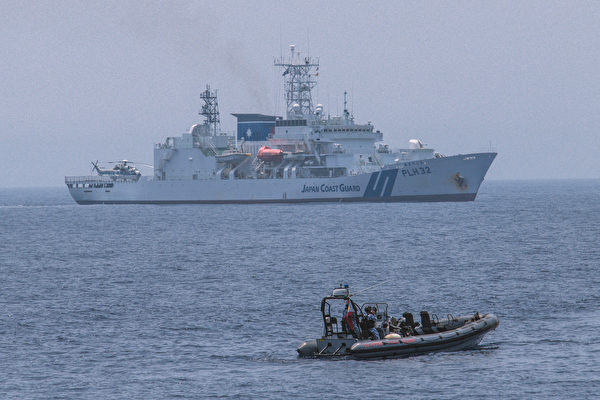Recently, the Chinese Coast Guard has two world’s largest patrol ships of 10,000 tons each, operating in the East China Sea and the South China Sea. In order to counter Chinese threats and provocations, Japan has been conducting maritime cooperation with the United States, South Korea, and providing large patrol ships to the Philippines. Additionally, Japan has decided to build a massive 30,000-ton patrol ship, equipped with the capability to function as a “sea base,” in preparation for any potential crisis involving Taiwan.
The Japanese government’s decision to construct the largest patrol ship in history comes as a response to frequent incursions by Chinese Coast Guard vessels, particularly the 10,000-ton “2901” vessel, around the disputed Senkaku Islands (known as Diaoyu Islands in China).
The newly planned patrol ship is expected to be 200 meters in length, with a total of 30,000 tons in weight, and will provide functions as a “sea base,” capable of carrying dozens of high-performance rubber boats, three helicopters, and deterring personnel from landing on islands. In the event of a conflict in Taiwan, it can evacuate up to 1,500 residents of the Ryukyu Islands at once. The ship will also feature container storage space for versatility.
During its maritime missions, the patrol ship can double as a “sea outpost” to command other patrol ships effectively. Japan’s Maritime Safety Agency aims to commission the 30,000-ton patrol ship by 2029 and plans to construct two more similar vessels in the future. Currently, the largest patrol ship in Japan’s Maritime Safety Agency fleet is of 6,500 tons.
The Chinese Coast Guard, officially known as the Chinese People’s Armed Police Maritime Police Force, has been under the jurisdiction of the Armed Police Force since 2018. By the end of 2023, they possessed a total of 120 government vessels over 1,000 tons, making it one of the largest and most advanced maritime law enforcement forces in the world.
Chinese Coast Guard ships routinely navigate the waters around the disputed Senkaku Islands with Japan, a practice that has become a standard operational procedure.
According to Japan’s Maritime Safety Agency, on June 7th at around 10 am, four Chinese Coast Guard ships entered the waters near the Senkaku Islands, navigated for about an hour and a half, and departed at 12:25 pm to the adjacent waters. All four ships were armed with guns—a departure from the usual practice where only one ship in a fleet carries weaponry.
Chinese Coast Guard ships are virtually present in the waters adjacent to Japan on a daily basis, with a total of 352 days of sailings last year, the highest in history. Since December 22nd of last year, they have continuously sailed for 169 days, setting a new record for the most consecutive days of sailing. Moreover, between March last year and April this year, Chinese Coast Guard ships spent a total of 80 hours and 36 minutes in Japanese territorial waters, the longest duration in history.
Among the Chinese Coast Guard fleet, the largest vessel is 10,000 tons, with two ships, “2901” and “5901,” operating in the East and South China Seas respectively. Notably, the “2901” ship, stationed in the East China Sea, is 165 meters long and equipped with a 76 cm caliber gun.
In the past, when the largest Chinese Coast Guard ships entered disputed areas, they often deactivated their AIS (Automatic Identification System) to navigate covertly. However, in recent years, they have intentionally activated the system, transmitting signals indicating their location to assert their presence in the area. The Japanese Maritime Safety Agency interprets this as a show of force to increase their visibility.
Utilizing AIS data, the Japanese public broadcaster NHK tracked and analyzed the movements of the Chinese Coast Guard’s “2901” ship. The data showed that over the past few years, the ship has continuously emitted its location information, especially when sailing near the middle line of the East China Sea, sometimes crossing it.
In 2008, Japan and China agreed on joint development of oil fields in the East China Sea, but China subsequently began independent drilling operations. The “2901” ship has been frequently sighted near these oil fields.
In February this year, the ship sailed in waters east of Taiwan-controlled Orchid Island, and in April, it sailed about 80 kilometers off the coast of Okinawa Prefecture, near the Senkaku Islands, while transmitting AIS signals. Japan views these actions as provocative displays.
Koichi Sato, a professor at Sakurajima University, stated that the activities of the “2901” hold symbolic significance for China: demonstrating to the domestic audience that China possesses the world’s largest patrol ship, and sending a message of intimidation externally. The broadcasting of AIS signals serves as a declaration to Japan, the Chinese people, and the Chinese authorities that they are active.
The “2901” ship is considered the flagship vessel of the Chinese People’s Armed Police Maritime Police Force in the East China Sea and is usually stationed in Zhejiang Province.
During a visit to the East China Sea Command Headquarters on November 29 last year, the Chinese leader Xi Jinping remotely inspected the tasks of the Coast Guard vessel, featuring prominently the “2901.”
NHK’s report on June 2 analyzed that China will continue to use the symbolic vessel “2901” to enhance its presence in the East China Sea, including around the Senkaku Islands, to gauge Japan’s reaction. Japan’s Maritime Safety Agency is actively monitoring the situation and has taken appropriate measures. The construction of the new 30,000-ton patrol ship is part of Japan’s strategic response plan.

